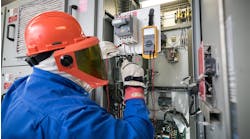In Episode 27 of “EC&M Tech Talk,” Randy Barnett, a journeyman electrician, inspector, author, trainer, and electrical safety expert, reviews the purpose and methods used for measuring the quality of electrical insulation on conductors and equipment. Insulation testing is the commonly used method for several reasons. Performing a spot reading test gives a quick evaluation of the condition of the insulation. This test can identify if further testing is required. The resultant readings (when plotted over time) can be used for predictive maintenance.
More advanced testing for motors includes the polarization index (PI) test and the dielectric absorption ratio (DAR) tests. These tests can identify impurities in the motor windings; a condition that can often be corrected through cleaning and drying of windings.
Understanding the theory behind insulation resistance testing helps to select the proper test voltage. Safety is always key. Charging a long cable run or motor with 1,000V or more can result in charges remaining in the equipment for a time after turning off the megohmmeter. It is the worker’s responsibility to ensure circuits are discharged before coming in contact with them.
Insulation resistance testing involves using a megohmmeter for troubleshooting and preventative maintenance. Readings are provided in ohms, and it is the electrical worker who must interpret those readings to determine equipment condition and long-term expectations for equipment operation.



